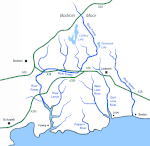St Cyricius and St Julietta's Church, St Veep
14th-century church buildings in EnglandChurch of England church buildings in CornwallGrade I listed churches in Cornwall

St Cyricius and St Julietta's Church, St Veep is a Grade I listed parish church of Church of England in St Veep, Cornwall.
Excerpt from the Wikipedia article St Cyricius and St Julietta's Church, St Veep (License: CC BY-SA 3.0, Authors, Images).St Cyricius and St Julietta's Church, St Veep
Fore Street,
Geographical coordinates (GPS) Address Website External links Nearby Places Show on map
Geographical coordinates (GPS)
| Latitude | Longitude |
|---|---|
| N 50.365388888889 ° | E -4.6166666666667 ° |
Address
St Veep (St Cyriacus & St Julitta)
Fore Street
PL22 0PF , St. Veep
England, United Kingdom
Open on Google Maps










